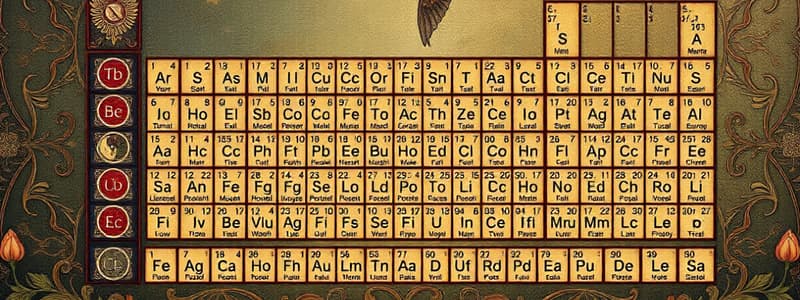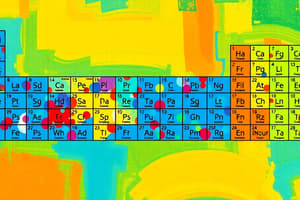Podcast
Questions and Answers
What is a defining property of metals?
What is a defining property of metals?
- Non-reactive with water
- Dull appearance
- Ductile and malleable (correct)
- Poor conductors of heat
Which group in the periodic table contains soft, white, shiny metals?
Which group in the periodic table contains soft, white, shiny metals?
- Group IIA
- Group VIIA
- Group IA (correct)
- Group 0
How are elements arranged in the periodic table across rows?
How are elements arranged in the periodic table across rows?
- By increasing atomic mass
- Vertically into groups
- By similar chemical properties
- Horizontally into periods (correct)
What is a characteristic of solid non-metals?
What is a characteristic of solid non-metals?
Which of the following statements about rare earth elements is true?
Which of the following statements about rare earth elements is true?
What are metalloids primarily known for in comparison to metals and non-metals?
What are metalloids primarily known for in comparison to metals and non-metals?
What can be inferred about the last element in any period of the periodic table?
What can be inferred about the last element in any period of the periodic table?
What was Dmitri Mendeléev's contribution to the periodic table?
What was Dmitri Mendeléev's contribution to the periodic table?
What distinguishes a compound from a mixture?
What distinguishes a compound from a mixture?
Which of the following statements is true about non-metals?
Which of the following statements is true about non-metals?
Which property differentiates elements in the same group of the periodic table?
Which property differentiates elements in the same group of the periodic table?
How can compounds be separated?
How can compounds be separated?
What happens when the subatomic particles of an element are separated from its atom?
What happens when the subatomic particles of an element are separated from its atom?
What characteristic is not typical of metals?
What characteristic is not typical of metals?
What is a common trait of mixtures?
What is a common trait of mixtures?
What indicates a predictable change in a particular direction in the periodic table?
What indicates a predictable change in a particular direction in the periodic table?
What is the primary purpose of the periodic table?
What is the primary purpose of the periodic table?
Which statement accurately describes hydrogen's position in the periodic table?
Which statement accurately describes hydrogen's position in the periodic table?
What can be predicted based on an element's position in the periodic table?
What can be predicted based on an element's position in the periodic table?
What is an atomic mass unit (AMU) primarily used to measure?
What is an atomic mass unit (AMU) primarily used to measure?
What information is typically included within an element's square on the periodic table?
What information is typically included within an element's square on the periodic table?
How many AMUs are in one gram?
How many AMUs are in one gram?
What is true about ions in relation to periodic trends?
What is true about ions in relation to periodic trends?
What characterizes how elements are grouped in the periodic table?
What characterizes how elements are grouped in the periodic table?
Flashcards
What are pure substances?
What are pure substances?
Substances that are made from only one type of atom are called pure substances.
What are compounds?
What are compounds?
Substances that are made from more than one type of atom bonded together are called compounds.
What are mixtures?
What are mixtures?
Compounds that are combined physically, but not chemically, are called mixtures.
How can mixtures be separated?
How can mixtures be separated?
Signup and view all the flashcards
How can compounds be separated?
How can compounds be separated?
Signup and view all the flashcards
What happens when an element's subatomic particles are separated?
What happens when an element's subatomic particles are separated?
Signup and view all the flashcards
What is a trend in the periodic table?
What is a trend in the periodic table?
Signup and view all the flashcards
Why do trends occur in the periodic table?
Why do trends occur in the periodic table?
Signup and view all the flashcards
What is the periodic table?
What is the periodic table?
Signup and view all the flashcards
What is atomic number?
What is atomic number?
Signup and view all the flashcards
What is the Periodic Law?
What is the Periodic Law?
Signup and view all the flashcards
What are groups (families) in the periodic table?
What are groups (families) in the periodic table?
Signup and view all the flashcards
What are periods in the periodic table?
What are periods in the periodic table?
Signup and view all the flashcards
Where are transition metals located in the periodic table?
Where are transition metals located in the periodic table?
Signup and view all the flashcards
What is ionization energy?
What is ionization energy?
Signup and view all the flashcards
What is atomic radius?
What is atomic radius?
Signup and view all the flashcards
What are Groups or Families?
What are Groups or Families?
Signup and view all the flashcards
What are Periods?
What are Periods?
Signup and view all the flashcards
What is the significance of valence electrons?
What is the significance of valence electrons?
Signup and view all the flashcards
What are the main characteristics of metals?
What are the main characteristics of metals?
Signup and view all the flashcards
How do metals react with water?
How do metals react with water?
Signup and view all the flashcards
What are Metalloids?
What are Metalloids?
Signup and view all the flashcards
What are the main characteristics of non-metals?
What are the main characteristics of non-metals?
Signup and view all the flashcards
What stays the same across a period?
What stays the same across a period?
Signup and view all the flashcards
Study Notes
Periodic Table
- The periodic table organizes elements in a specific way.
- A significant amount of information about an element can be obtained from its position in the table.
- Predicting physical and chemical properties of an element is possible using the periodic table.
- The periodic table helps understand how elements react with other elements.
- The table contains basic information on all 118 known elements.
Learning Objectives
- Understand why chemists use the periodic table.
- Identify the location of groups, periods, and transition metals within the table.
- Analyze periodic trends in ionization energy, atomic radius, and electronegativity.
- Connect periodic trends to the atomic structure of elements.
Periodic Law
- The repeating physical and chemical properties of elements change periodically with the atomic number.
What's in a Square?
- Each element square contains unique information, like:
- Symbol
- Average atomic mass
- Physical state (gas, liquid, solid)
- Atomic number
- Name
- Valence electrons
Hydrogen
- Hydrogen sits above Group Al, but it's a unique element.
- Hydrogen is a gas at room temperature.
- It has one proton and one electron in its single energy level.
- It needs 2 electrons to fill its valence shell.
Atomic Mass Unit (AMU)
- The unit for measuring an atom's mass is the AMU.
- AMU stands for atomic mass unit.
- One AMU equals the mass of one proton.
- There are 6.02 x 10^23 AMUs in one gram.
- Electrons are much smaller than one AMU.
Symbols
- Each element has its own unique symbol.
- A symbol can be one capital letter or a capital letter followed by one or two lowercase letters.
- Examples include carbon (C) and copper (Cu).
Common Elements and Symbols
- A table is provided listing various elements and their symbols.
Classification of Elements in the Periodic Table
- Elements are categorized into groups (vertical columns) and periods (horizontal rows).
Properties of Metals
- Metals are good conductors of heat and electricity.
- Metals are typically shiny.
- Metals can be drawn into wires (ductile) and hammered into sheets (malleable).
- A chemical property of metals is their reaction with water, which can result in corrosion.
Properties of Metalloids
- Metalloids have properties of both metals and nonmetals.
- Metalloids are usually solid.
- Metalloids can be shiny or dull.
- Metalloids are better electrical conductors than nonmetals but not as good as metals.
- Metalloids are ductile and malleable.
Properties of Nonmetals
- Nonmetals are poor conductors of heat and electricity.
- Solid nonmetals are usually brittle and break easily.
- Nonmetals are typically dull.
- Many nonmetals are gases.
Rare Earth Elements
- Thirty rare earth elements are composed of lanthanide and actinide series.
- Most lanthanide series and transuranium/actinide elements are synthetic substances.
Mendeleev
- Dmitri Mendeleev created the first accepted periodic table in 1869.
- It grouped elements according to atomic mass and similar chemical properties.
- This table included blank spaces to accommodate future discoveries of elements.
Matter
- All matter consists of atoms and atom groups bonded together, called molecules. Pure substances are made of only one type of atom. Substances made from more than one type of atom form compounds. Mixtures result from combining compounds physically without chemical bonding.
Elements, Compounds, Mixtures
- Sodium and chlorine combine chemically to form sodium chloride, commonly known as table salt, a compound.
- Elements, compounds, and mixtures can be separated by different methods.
- Mixtures separate using physical methods whereas compounds need chemical methods to separate.
- Elements are pure substances.
Trends in the Periodic Table
- Trends in the periodic table are predictable changes in various properties.
- Atomic number affects nuclear attraction across a period (increasing attraction).
- Shielding effect causes decrease in nuclear attraction down a group.
Atomic Radius
- Atomic radius is the distance from an atom's center to its outermost electrons.
Atomic Radius Trend
- The atomic radius generally increases down a group and decreases across a period.
Ionization Energy Trend
- Ionization energy is the energy needed to remove an electron from an atom or ion.
- Ionization energy generally increases across a period and decreases down a group.
Electronegativity Trend
- Electronegativity is an atom's ability to attract electrons in a chemical bond.
- Electronegativity generally increases across a period.
- Electronegativity generally decreases down a group.
What is a Compound?
- A compound is a substance formed when two or more different elements are chemically bonded.
What is the chemical bond?
- The question provides an inquiry, not a statement.
Reference
- Information was sourced from various general chemistry, organic chemistry, biochemistry texts and the internet.
Studying That Suits You
Use AI to generate personalized quizzes and flashcards to suit your learning preferences.



